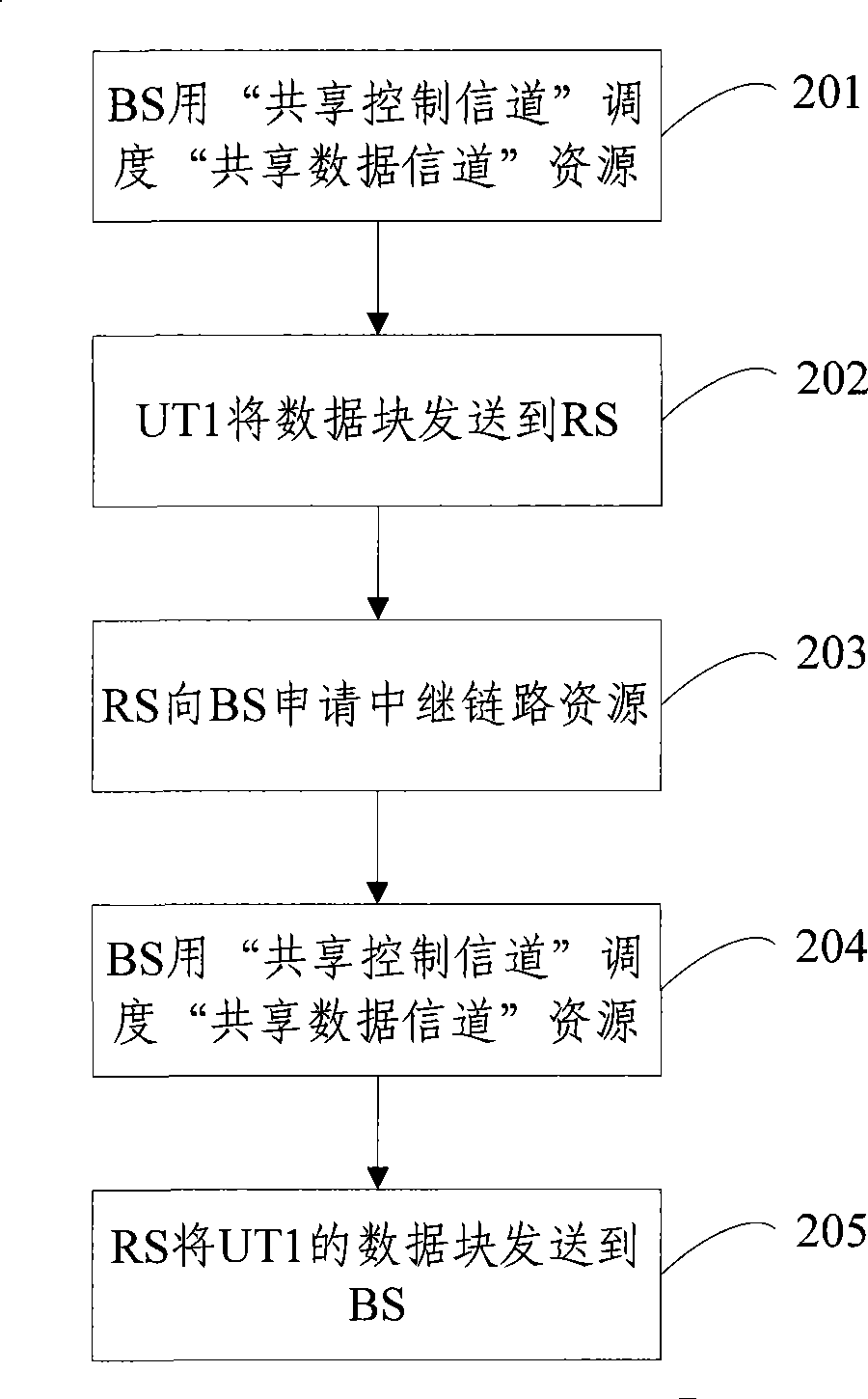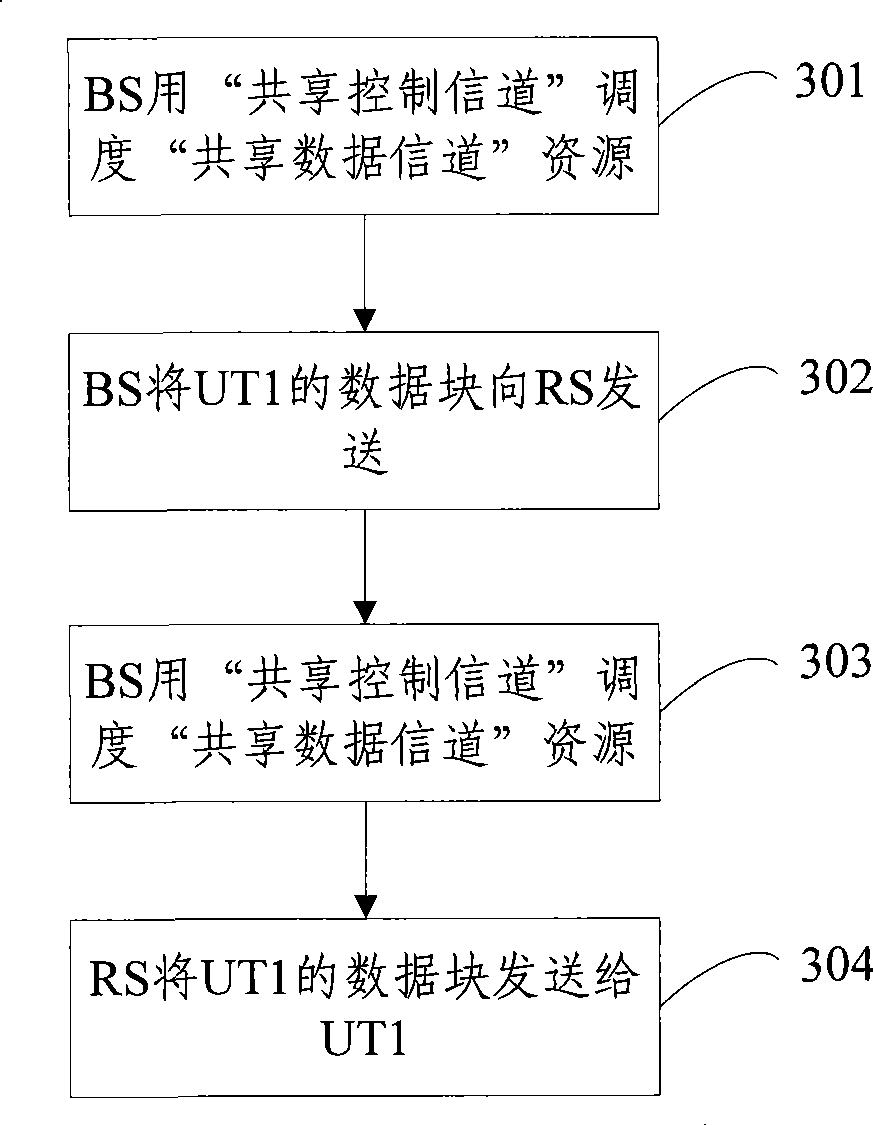Method, relay and base station for data transmission on relay link
A relay link and data transmission technology, applied in the field of data transmission, can solve the problems of resource waste, size mismatch, and large resource consumption, and achieve the effects of avoiding waste, reducing overhead, and saving air interface resources
- Summary
- Abstract
- Description
- Claims
- Application Information
AI Technical Summary
Problems solved by technology
Method used
Image
Examples
Embodiment 1
[0111] Embodiment 1: as Figure 4Shown is the flow chart of the uplink data transmission method in the 2-hop relay scenario of the present invention. The system includes terminals UT1, UT2, UT3, etc., a base station BS and a relay RS1. Of course, there are many UTs, BSs, and RSs in the system. In this embodiment, the concept of the present invention is described in a relatively simple case, and the processing of other cases is changed accordingly based on this case, which is similar to this embodiment. The steps are as follows:
[0112] Step 401: For the data blocks of multiple terminals such as UT1, UT2, UT3, etc., the BS uses the "shared control channel" to schedule "shared data channel" resources for them respectively, and the resources are access link resources.
[0113] Step 402: UT1, UT2, UT3, etc. use the resources allocated to them by the BS in step 401 to send data blocks to RS1 respectively.
[0114] Step 403: After receiving the data blocks of UT1, UT2, UT3, etc.,...
Embodiment 2
[0127] The uplink data transmission process of the 2-hop relay scenario described in Embodiment 1 above, when it is a k (k>2) hop relay scenario, as follows Figure 5 As shown, assuming that relays RS A and RS B are deployed in the system, when transmitting uplink data from RS A to RS B, the steps are:
[0128] Step 501: RS A separates the received concatenated data blocks to obtain data blocks respectively belonging to different UTs;
[0129] Step 502: For all data blocks to be sent, RS A determines the sending time of the data block and the next hop destination;
[0130] Step 503: RS A collectively applies for relay link resources from BS for the data blocks to be sent at the same time;
[0131] Step 504: The BS uses the "shared control channel" to schedule "shared data channel" resources, and the resources are relay link resources;
[0132] Step 505: According to the size of allocated resources, concatenate the data blocks that need to be sent at the same time and have th...
Embodiment 3
[0155] Such as Figure 7 Shown is a flow chart of a downlink data transmission method in a 2-hop relay scenario. The system includes terminals UT1, UT2, UT3, etc., a base station BS, and a relay RS1. Of course, in the system, there are many UTs, BSs, and RSs. In this embodiment, the idea of the present invention is described in a relatively simple situation. The processing of other situations is based on this situation. resemblance. The steps are as follows:
[0156]Step 701: Before the BS sends downlink data to the relay RS1, it first determines which UTs need to send the data blocks at the time of sending.
[0157] Before the BS sends data to RS1, the BS first determines that the data blocks belonging to UT1, UT2, and UT3 need to be sent at the time of sending.
[0158] Step 702: The BS uses the "shared control channel" to schedule a "shared data channel" resource, which is a relay link resource.
[0159] Step 703: The BS concatenates the data blocks of UT1, UT2, and U...
PUM
 Login to View More
Login to View More Abstract
Description
Claims
Application Information
 Login to View More
Login to View More - R&D
- Intellectual Property
- Life Sciences
- Materials
- Tech Scout
- Unparalleled Data Quality
- Higher Quality Content
- 60% Fewer Hallucinations
Browse by: Latest US Patents, China's latest patents, Technical Efficacy Thesaurus, Application Domain, Technology Topic, Popular Technical Reports.
© 2025 PatSnap. All rights reserved.Legal|Privacy policy|Modern Slavery Act Transparency Statement|Sitemap|About US| Contact US: help@patsnap.com



